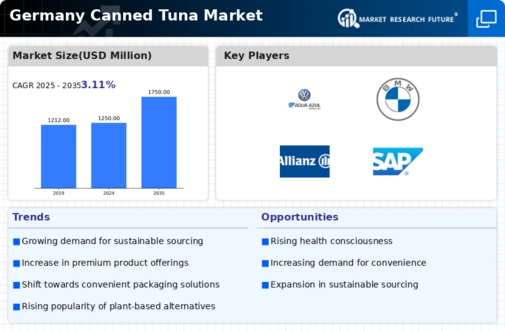The Germany Canned Tuna Market is characterized by intense competition among various players striving to establish a stronger foothold. Strong consumer demand for canned seafood products, driven by convenience and perceived health benefits, has prompted numerous companies to innovate and diversify their offerings. In recent years, the market has seen a shift towards sustainable sourcing practices, leading to increased collaborations with fishing organizations and environmental agencies. Companies are also investing in effective marketing strategies to highlight the quality, taste, and nutritional advantages of their products.
In conjunction with sustainability trends, the importance of branding has become increasingly evident as consumers look for trusted labels that align with their values. Consequently, the competitive landscape is witnessing continuous product enhancements, value-added propositions, and streamlined distribution channels.In the context of the Germany Canned Tuna Market, Starkist has positioned itself as a significant player with a robust presence. The company is known for its extensive range of canned tuna products that cater to diverse consumer preferences, focusing on quality and convenience. Starkist emphasizes its commitment to sustainably sourced tuna, which resonates well with the environmentally conscious German market.
The brand has established a loyal customer base through effective marketing campaigns and strategic partnerships, further enhancing its market visibility. Additionally, Starkist’s ability to adapt quickly to changing market demands and consumer trends gives it a competitive edge, enabling the company to capitalize on opportunities within the canned tuna segment.Mitsubishi Corporation also plays a crucial role in the Germany Canned Tuna Market, leveraging its global distribution network and operational expertise. The company is known for offering a wide range of canned seafood products, including different varieties of tuna that appeal to various consumer demographics.
Mitsubishi Corporation places significant emphasis on quality control and sustainable practices, ensuring that its products meet high standards and consumer expectations. The company's strengths lie in its robust supply chain management, allowing it to effectively manage sourcing and distribution while minimizing costs. Through strategic mergers and acquisitions, Mitsubishi has been able to expand its product offerings and increase its market reach within Germany, adapting to local preferences and demands. By focusing on innovation and sustainability, Mitsubishi Corporation is well-positioned to continue playing a significant role in shaping the competitive dynamics of the canned tuna market in Germany.














